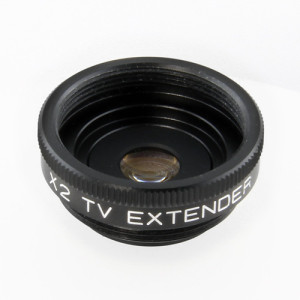Rear converters are lens elements added at the rear of lenses, between lens and camera.
They are marked with a magnification factor larger than 1 : x1.5, x2, x2.5 etc
Their intended purpose is to increase the focal length of lenses by this factor, which is roughly equivalent to multiplying the magnification of a lens by this factor.
For now, lets assume we are dealing with a 2x converter. Other magnifications work accordingly.
As magnification is defined by image size divided by object size, there are two ways to double the magnification. This results in two types of rear converters:
- The field of view (FOV) is reduced by factor 2 and the image size stays the same
- The FOV stays the same, but the image increases by factor 2.
e.g. a lens that supported 1/2″ (d=8mm) can support 2x8mm = 16mm = 1″ with the converter.
Type 2 is useful if you want to change to a larger sensor, while keeping the FOV and the pixel count. Type 2 can be used as Type 1, by simply using it on the old sensor size.
The positive features are:
- The focal length doubles (as intended)
- Vignetting (dark corners) decreases
- Type-1 converters reduce the distortion of the image.
This is because a lens usually has a larger distortion at the rim of an image and a type 1 converter enlarges the (low distortion) center.
There are unwanted features, however:
- The F-number doubles, which results in the image being 4 times (=M*M) darker.
The F-Number is defined as ratio focal length, divided by entrance pupil diameter. The entrance pupil didn’t change, but the focal length doubled. - Resolution is reduced by factor M*M = 4, so a 5 Mega lens turns into the equivalent of a 1.3 Mega lens on the same sensor.
This is because the Rayleigh criterion, that tells us that the diameter of the smallest spot a diffraction limited lens can generate is D=2*1.22*wavelength*F#. Because the F# doubles, the diameter doubles, and therefore the resolution is reduced by factor two both horizontally and vertically.
Unexpected features are possible too:
- Vignetting might increase on certain sensors.
Sensors like the 1.3Mega and the 2 Mega of E2V have shifted microlenses and expect CRAs of 12 degrees in the corner. As the converter descreases the CRA, the CRA might become too small and cause vignetting.
- For type 1 of the converter the resulting image has a magnification that is only approximately and not exactly factor 2
Because the converter enlarges only the center of the lens (where there is less distortion), the resulting image has less distortion, and a different magnification.
There seem to be more negatives than positives when it comes to using rear converters.
In terms of resolution, we could get the same effect simply through software.
Type 2 of the converter allows the use of larger sensors. Therefore a lens designed for 1/2″ and 1.3 Mega resolution works quite well on a 1″ sensor at 1.3 Megapixels (but not on a 4 Mega 1″ 😉 )
Both types do not need a change in working distance when the converter is mounted.
